- Joined
- Feb 9, 2014
- Messages
- 20,922
- Name
- Peter
http://bleacherreport.com/articles/...-have-improved-the-most-so-far-this-offseason
Which NFL Teams Have Improved the Most so Far This Offseason?
By Sean Tomlinson, NFL Analyst, July 22, 2015
Each year in late January and early February the Super Bowl hype grows for two weeks, with a buzz building into the Sunday roar. Then there's...nothing.
Nothing but a cold, cruel winter ahead, which often gets even darker when your favorite player retires, isn't re-signed or becomes a cap casualty. (San Francisco 49ers fans are rather familiar with all three.)
But the sun starts to shine brighter both literally and figuratively in the spring, when the true blossoming of a rebuild takes shape. Or maybe this year it was a reinforcement, as was the case with the Indianapolis Colts and the guy pictured above, and the Seattle Seahawks with tight end Jimmy Graham.
There's hope to be found beginning in March regardless. And yet real, meaningful football is still so far away.
Now it's nearly here with rookies for the Baltimore Ravens, Cleveland Browns and New Orleans Saints reporting to training camp on Wednesday. That means a critical question will be answered: Which teams improved the most this offseason?
I have answers to that question. In fact, I have 10 of them.
As training camps open, here are the most improved teams after the offseason shuffling.
St. Louis Rams

Michael Thomas/Associated Press
Key signings/trades: QB Nick Foles, DT Nick Fairley
Key draft picks: RB Todd Gurley, QB Sean Mannion
It remains to be seen which Nick Foles the St. Louis Rams will ultimately receive in their trade with the Philadelphia Eagles. Will it be the quarterback who threw just two interceptions over 317 pass attempts in 2013? Or the guy who required only 311 attempts to heave 10 picks in 2014?
Either way there’s far more hope that Foles can reintroduce something that was missing among Rams quarterbacks: competence.
Eventually, the Rams would love to have dazzling quarterback play. Every team wants that, and it’s in short supply. But to break free from a record that’s nearly mediocrity defined under head coach Jeff Fisher (a .427 winning percentage), the Rams just need a quarterback who can be impressively adequate.
Why? Because now their defensive line has gone from suffocating to dismantling after the addition of tackle Nick Fairley.
He was added on the standard one-year “prove it” deal, which should minimize any character concerns hovering around an interior pass-rusher who has 12.5 sacks over the past three years despite missing 11 games during that time.
Fairley joins a front that’s already powered by 2014 Defensive Rookie of the Year Aaron Donald. He finished his first season with 44 total pressures, per PFF. Then there’s defensive end Robert Quinn, who has the league’s third-most sacks since 2012 (40).
Between adding to a strength with Fairley and selecting running back Todd Gurley—he of the 6.4 yards per carry over three collegiate seasons—with their 10th overall pick, the Rams have put themselves in a position to win with a classic power approach on both sides of the ball.
Having a quarterback who can meet the minimum standards for satisfactory play is a nice, and necessary, bonus. It also could be the only hurdle left to clear before the Rams become a playoff contender.
Seattle Seahawks
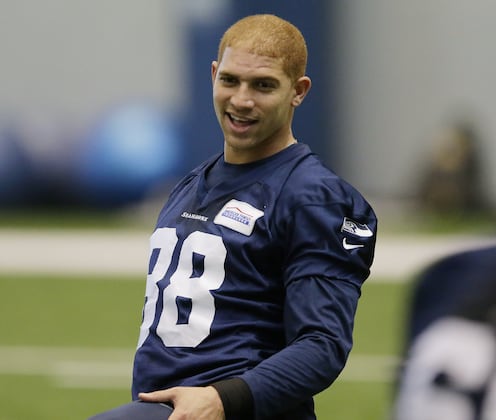
Ted S. Warren/Associated Press
Key signings/trades: TE Jimmy Graham, CB Cary Williams
Key draft picks: WR Tyler Lockett, DE Frank Clark
The Seattle Seahawks acquired tight end Jimmy Graham earlier this offseason in a trade that sent center Max Unger and a first-round pick to the New Orleans Saints. For the rest of the league, that was pretty much the equivalent of Superman’s immune system finally developing a resistance against Kryptonite.
Two sources of brute force have powered the Seahawks to appearances in back-to-back Super Bowls: defense and power running. Those core strengths and focuses aren’t going anywhere, but now the team has added a missing piece.
The Seahawks’ passing game has often consisted of controlled chaos, with quarterback Russell Wilson manipulating the pocket or creating space outside of it until there’s an opening downfield. It’s an approach that’s set up by that power running game, but a large, reliable target has been absent during key moments.
Like, say, that moment when Seattle needed one yard to win the Super Bowl.
Graham instantly solves a trust problem between Wilson and his receiving options. The tight end is a well-established red-zone behemoth, and his 46 touchdown receptions since 2011—when Graham first started getting full-time snaps in New Orleans—lead all tight ends.
The 6’7” athletic marvel adds a new dimension to an offense that's been almost purely run-oriented, and his red-zone presence alone will make the Seahawks offense downright unfair.
Graham can elevate Seattle’s passing offense to another tier in an area of the field where it matters most. And perhaps even more importantly, he’ll also make opposing defenses hesitate as they key on running back Marshawn Lynch near the goal line.
Elsewhere, cornerback Cary Williams might be impressively adequate overall. But his feisty, tenacious physical style fits the Seahawks’ brand of gut-punching defense. He came at the bargain basement cost of only $7 million in guaranteed money, which makes Williams a cheap Byron Maxwell replacement.
Buffalo Bills
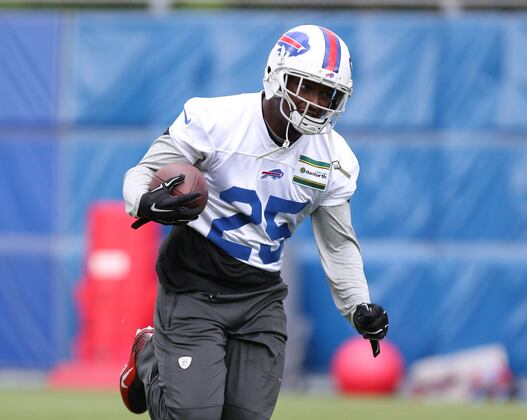
Kevin Hoffman-USA TODAY Sports
Key signings/trades: WR Percy Harvin, RB LeSean McCoy, TE Charles Clay, FB Jerome Felton, G Richie Incognito, QB Matt Cassel, re-signed DE Jerry Hughes
Key draft picks: CB Ronald Darby, RB Karlos Williams, TE Nick O’Leary
Right now we’re left repeatedly asking a question about the Buffalo Bills roster as it’s currently assembled: Is it possible to win a Super Bowl without a star quarterback?
We’ll be asking that same question in September, and then again in December when the temperature is cranked on playoff races. By January we’ll have our answer, and an experiment in quarterback hiding will be over.
Looking past the quarterback position requires jumping through a difficult mental hurdle. The NFL is at the height of a passing era, and quarterbacks are the cornerstone of championship teams. Consider the quarterbacks at the helm of Super Bowl-winning teams over the past five years: Tom Brady, Russell Wilson, Joe Flacco, Eli Manning and Aaron Rodgers. They’ve combined for 19 Pro Bowl appearances.
But close your eyes really tight and let the vision of Buffalo’s new roster dance around.
You see running back LeSean McCoy, who’s still in his prime at 27 years old. Half of his six NFL seasons have ended with 1,600-plus yards from scrimmage.
You see Percy Harvin, a slot receiver and return man who has struggled recently because of injuries. But when healthy and used properly, he can be a consistently dangerous threat in space. In 2012 he finished with 542 yards after the catch, per Pro Football Focus, even while appearing in only nine games.
And you see tight end Charles Clay, who’s also a yard-after-catch compiler at his position. Clay finished fifth among all tight ends with 373 yards after the catch in 2014 during his final year with the Miami Dolphins, per PFF.
You also see Jerome Felton, a Pro Bowl fullback, and Richie Incognito, who was among the league’s best guards before his falling-out in Miami (only seven sacks allowed over his final two full seasons there, per PFF). Oh, and you see the fourth-ranked defense in 2014 that’s mostly remained in place. Buffalo traded linebacker Kiko Alonso for McCoy, but he didn’t play in 2014 because of a torn ACL.
Everything about that roster says playoffs, especially when Harvin is placed on a receiver depth chart that also includes Sammy Watkins and Robert Woods. This is when I remind you the Bills haven’t sniffed playoff football since a strange time in our lives when we were first discovering Napster.
About those quarterbacks—Cassel is a journeyman who hasn’t been deemed worthy of a full-time starting role since 2010. EJ Manuel is a spiraling potential draft bust who’s completed only 58.6 percent of his career throws. Tyrod Taylor has attempted 35 career regular-season passes.
The Bills have assembled the required offensive pieces to hide the quarterback. Now we’ll see if hiding a quarterback is actually possible.
New York Jets

Ed Mulholland-USA TODAY Sports
Key signings/trades: CB Darrelle Revis, CB Antonio Cromartie, CB Buster Skrine, re-signed ILB David Harris, WR Brandon Marshall, RBStevan Ridley, G James Carpenter
Key draft picks: DE Leonard Williams, WR Devin Smith
A general manager is free to consider his offseason a success if he addresses one major weakness and then adequately slots in pieces to fill others. That’s often the reality of doing business in a salary-cap era.
But New York Jets rookie GM Mike Maccagnan did more than finish his offseason shopping with one big-ticket item. He filled up at least three Costco-sized shopping carts with his wealth of cap space and then left the building feeling like a bulked-up brick house.
In 2014 the Jets secondary often resembled an airport moving walkway, giving opposing pass-catchers easy jogs into the end zone. The Jets allowed the third-most passing touchdowns (31) and the third-highest opposing passer rating (101.5).
So that need was screaming at Maccagnan. He responded by reassembling the Jets’ cornerback tandem from 2010 to 2013, landing both Darrelle Revis and Antonio Cromartie.
Revis is among the few truly premier cover corners who can shut down half the field. He allowed a reception only once every 14.8 snaps during his lone year with the New England Patriots, per PFF, while Cromartie finished 10th in that category at 12.4.
New York also signed Buster Skrine, and he'll bring his four interceptions in 2014 to a Jets secondary that suddenly went from dismal to imposing.
That is especially frightening because the addition of first-round pick Leonard Williams means opposing quarterbacks will have maybe one moment to think and move. He’ll rotate in among a defensive line that also includes ends Muhammad Wilkerson and Sheldon Richardson, along with nose tackle Damon Harrison. They consistently collapsed the pocket for a defense that was already removing opposing quarterbacks from their undergarments, recording 45 sacks in 2014.
Offensively, quarterback Geno Smith has finally been given more receiving help in the form of wide receivers Brandon Marshall and Devin Smith. Marshall’s wingspan and ability to go full Velcro hands will give the scatter-armed quarterback a sense of security, while Smith’s speed (4.42 seconds in the 40-yard dash) will add a desperately needed vertical option.
A defensive weakness was addressed, a strength in the trenches became stronger, and the quarterback was supported. Now some fine offseason work needs to turn into on-field results under a new coaching staff led by Todd Bowles.
Indianapolis Colts
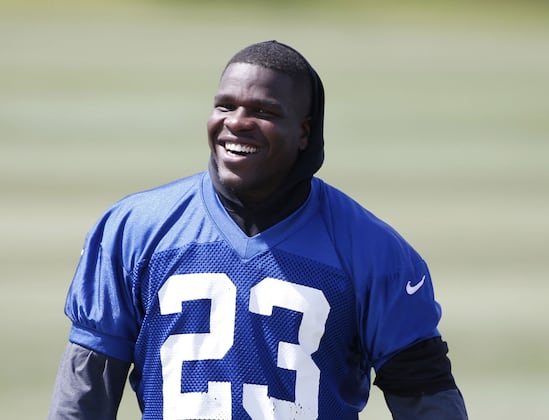
Brian Spurlock-USA TODAY Sports
Key signings/trades: RB Frank Gore, WR Andre Johnson, G Todd Herremans, OLB Trent Cole, ILB Nate Irving, re-signed ILB Jerrell Freeman, DE Kendall Langford
Key draft picks: WR Phillip Dorsett
The Indianapolis Colts looked ahead during the 2015 offseason and saw both a window that’s opening and a window that’s closing.
The short-term optimism simply comes from being able to call Andrew Luck their quarterback. He has ascended and placed himself among the league’s elite in just three short years, most recently averaging just a touch less than 300 passing yards per game (297.6) during a season that ended just one win shy of the Super Bowl.
But long-term caution also comes from Luck. Eventually, a premier quarterback will need to be paid accordingly, which means the Colts’ time of enjoying life without a hefty salary-cap anchor at that position will end.
That was surely on general manager Ryan Grigson's mind when he gathered his riches and threw many bills at the best available talent in an effort to finally clear that Super Bowl hump.
He needed to inject the rushing offense with some life after Indianapolis averaged only 3.9 yards per carry in 2014. The answer? Running back Frank Gore, who’s still effective despite his age (32) and has posted four straight 1,100-plus-yard rushing seasons.
He needed to give Luck a reliable set of veteran possession hands at wide receiver, a position overflowing with speed after Phillip Dorsett was selected in the first round. The answer? Andre Johnson, who’s also aging at 34 years old but is only one season removed from 1,407 receiving yards with the Houston Texans’ inferior quarterbacks.
And he needed to fortify a pass rush that was led by outside linebacker Jonathan Newsome in 2014, who finished with 6.5 sacks. The answer? Outside linebacker Trent Cole, who’s hit the double-digit-sack mark four times in his career and can double as insurance with the uncertainty surrounding fellow linebacker Robert Mathis’ recovery from a torn Achilles.
All three of Grigson’s marquee signings this offseason address core needs. But he accomplished that with players who are in or entering the twilight stage of their careers.
This is a Colts team built for winning a championship right now. Anything less is a failure.
Miami Dolphins
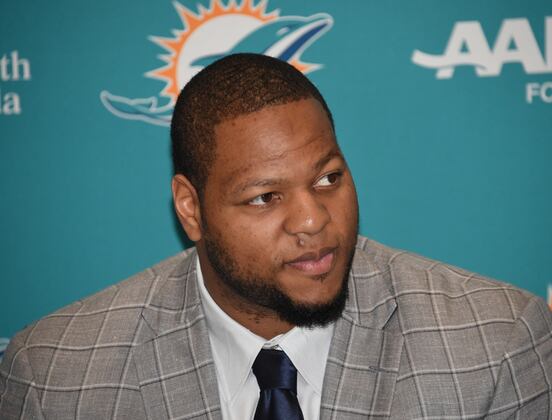
Ron Elkman/Sports Imagery/Getty Images
Key signings/trades: DT Ndamukong Suh, WR Kenny Stills, TE Jordan Cameron, WR Greg Jennings
Key draft picks: WR DeVante Parker, NT Jordan Phillips, RB Jay Ajayi
Ndamukong Suh recorded 57 pressures in 2014, which led all defensive tackles per PFF, and it wasn’t close (the Bills’ Kyle Williams was second with 49). Cameron Wake recorded 64 pressures, which slotted him fourth among 4-3 defensive ends.
Having them both on the same defensive line is about to get terrifying and harmful to the health of opposing quarterbacks.
When the Miami Dolphins formed that havoc-causing tandem, they immediately earned automatic real estate on any most improved list heading into the 2015 season. The addition of Suh came at a substantial and historic cost, as his six-year deal worth $114.4 million made him the highest-paid defensive player in NFL history.
The true pain doesn’t come until 2016, when Suh’s contract lays down the hammer of a $28.6 million cap hit. Difficult cap-balancing decisions will have to be made, and excess financial weight could be shed.
With that in mind, there’s plenty of talent in Miami to win both now and again down the road once the dust settles.
The team invested a first-round pick in wide receiver DeVante Parker, who finished his collegiate career at Louisville by averaging a whopping 19.9 yards per catch in 2014.
Adding to the speed and after-the-catch ability available for quarterback Ryan Tannehill is wideout Kenny Stills, whom the Dolphins acquired in a trade with the New Orleans Saints. He finished tied for fourth among all wide receivers in 2014 with six 40-plus yard receptions, even while being targeted a modest 80 times.
Tight end Jordan Cameron has been plagued by concussion issues recently, but he gives Tannehill yet another sure-handed option up the middle and a big target with his 6’5” height. Cameron is also just a year removed from trailing only Graham in tight end receiving yards (Cameron finished with 917 yards in 2013).
The tools are in place for the Dolphins both offensively and defensively. But the AFC East is still a hellish gauntlet for a team that is trying to win its first playoff game since 2000.
Kansas City Chiefs
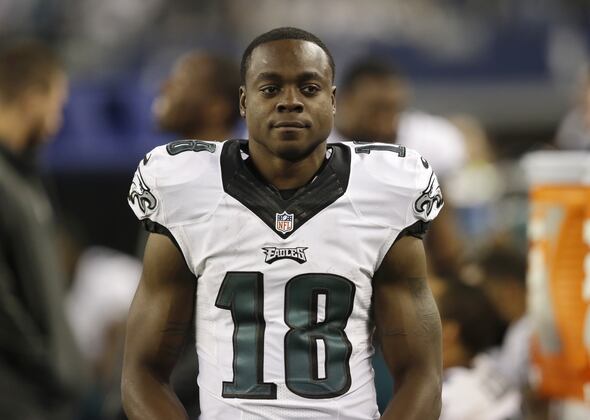
Tim Sharp/Associated Press
Key signings/trades: WR Jeremy Maclin, G Ben Grubbs, re-signed S Ron Parker, re-signed OLB Justin Houston
Key draft picks: CB Marcus Peters, WR Chris Conley
What the Kansas City Chiefs passing offense did in 2014—or rather didn’t do, ever—feels like it should be statistically impossible. Going an entire season without throwing one touchdown pass to a wide receiver should induce the same awestruck speechlessness as any rare astrological event.
Think Halley’s Comet meets orbiting Pluto.
The Chiefs did indeed play an entire season of competitive football without completing one touchdown pass to a wide receiver. Months later that’s still a remarkable sentence, even if Kansas City will likely never be considered a passing powerhouse with Alex Smith at quarterback and with head coach Andy Reid’s West Coast offense.
The Chiefs were the first team since 1964 to not log even one wide receiver touchdown. A dire need at the position became glaring, and the team addressed it with the most promising option available.
The Chiefs gave wide receiver Jeremy Maclin a five-year deal worth $55 million and then used an early-round pick on Chris Conley, who ran ablistering 4.35-second 40-yard dash at the scouting combine.
Maclin will have the more immediate impact and become a reliable weapon on the outside after his 85 receptions for 1,318 yards in 2014, both easily career highs. He’ll allow the offense to become more diverse and make life on 3rd-and-long attempts easier.
But the Chiefs will still stick with their core identity, which lies in the hands of running back Jamaal Charles. Acquiring two-time Pro Bowl guard Ben Grubbs from the New Orleans Saints is a move directly in line with what Reid aims to do offensively. Grubbs will help to give Charles some more running room and Smith more time to find Maclin deep.
Minnesota Vikings
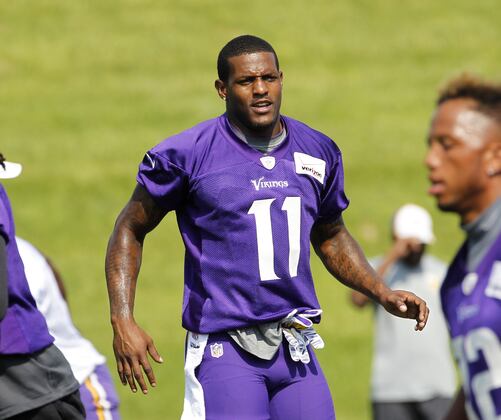
Ann Heisenfelt/Associated Press
Key signings/trades: WR Mike Wallace
Key draft picks: CB Trae Waynes, ILB Eric Kendricks
Mike Wallace is a polarizing wide receiver. It’s easy to be confused by his career of booming followed by a whole lot of busting.
He’s a field-stretching pass-catcher who thrives in a specific system, one that asks him to run far, run fast and then do it again. Which is why Minnesota Vikings offensive coordinator Norv Turner and quarterback Teddy Bridgewater are about to get along nicely with Wallace.
The Vikings acquired Wallace from the Miami Dolphins for a fifth-round pick, and adding him alone makes their offseason a success. Wallace floundered in Miami while paired with Tannehill, who has struggled with his deep-ball accuracy. But Bridgewater completed a solid 46.3 percent of his 20-plus yard attempts in 2014, per PFF, even though he lacked a true burner to take advantage of his precision placement.
Wallace is that guy now, and he's in an ideal situation with Turner’s emphasis on going vertical.
During most of his time with the Pittsburgh Steelers, the also vertical-minded Bruce Arians was Wallace’s offensive coordinator. The result? The now 28-year-old averaged 17.2 yards per catch over four seasons in Pittsburgh. That average peaked at 21.0 in 2010.
The Wallace-Bridgewater-Turner marriage should produce weekly aerial explosions, especially with the support of a strong rushing offense as running back Adrian Peterson returns.
Dallas Cowboys
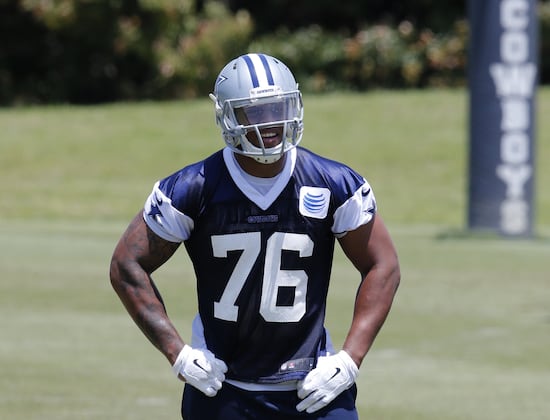
Matthew Emmons-USA TODAY Sports
Key signings/trades: DE Greg Hardy, OT La’el Collins, RB Darren McFadden, re-signed OT Doug Free, re-signed WR Cole Beasley
Key draft picks: DE Randy Gregory, CB Byron Jones
A standard disclaimer is needed every time we talk about Dallas Cowboys defensive end Greg Hardy and use the word "good." He’s good at football, but a previous conviction for domestic violence that was eventually dismissed on appeal has led to some serious questions about his character away from the field.
On the football side of things, both Hardy and fellow defensive end Randy Gregory will give the Cowboys something they so desperately need: reasons for opposing quarterbacks to be afraid.
The Cowboys’ pass rush was dealt a serious groin kick prior to the 2014 season when defensive end DeMarcus Ware became a cap casualty. Then a second swift kick came when DeMarcus Lawrence missed much of his rookie year with a foot injury.
The result was an often exposed defense due to its lack of pass-rushing depth. That problem will be a memory once Hardy returns from his four-game suspension.
Hardy finished third in 2013—his last full season—with 15 sacks. That completed a two-year stretch in which his blend of power and speed led to 26 sacks. He’ll add a dominating presence to the Cowboys' defensive front, especially once Gregory—who had 17.5 sacks over two seasons at Nebraska—fully develops at the next level.
Then there’s cornerback Byron Jones, who was selected a round earlier than Gregory. At 6’1” and 199 pounds, he fits the modern mold for large, looming and physical press corners on the outside. He will be a significant upgrade over both Morris Claiborne and Brandon Carr to start opposite Orlando Scandrick.
Washington Redskins
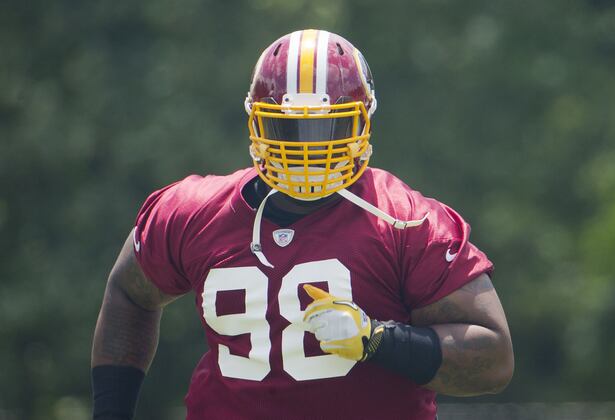
Pablo Martinez Monsivais/Associated Press
Key signings/trades: DE Stephen Paea, DE Rickey Jean-Francois, NT Terrance Knighton, CB Chris Culliver, S Dashon Goldson
Key draft picks: G Brandon Scherff, OLB Preston Smith
The Washington Redskins faced a three-pronged problem on their defensive line heading into the 2015 offseason: they were old, injured and overpaid.
Broadly, that describes nose tackle Barry Cofield and defensive end Stephen Bowen, who are both beginning to age and break (they had missed a combined 19 games over the past two seasons). The decision to cut them and save $10 million against the cap was easy.
The hard part? Moving quickly to find two upgrades or even suitable replacements at a reasonable price.
New general manager Scot McCloughan eyed that challenge and said “how about three?”
McCloughan signed nose tackle Terrance Knighton to a contract that arguably makes him the steal of free agency. The run-stuffing 331-pound mountain of a man recorded 22 defensive stops in 2014 for the Denver Broncos, per PFF. He did that even while being used almost strictly in a run-defense capacity, playing 49.1 percent of Denver’s defensive snaps.
And yet he’ll be paid only $4.5 million on a one-year contract in Washington.
Knighton will be asked to anchor and improve a run defense that allowed 107.6 rushing yards per game in 2014 (12th). He’ll do it alongside defensive end Stephen Paea, who agreed to a deal that pays him much more overall at $21 million over four years. But theguaranteed money Washington committed to Paea is still manageable at $7.85 million.
Paea is coming off a career-high six sacks in 2014. He was also effective as a run-stopper during his final year with the Chicago Bears, recording a stop on 6.6 percent of his snaps, per PFF.
Lastly, Washington signed defensive end Ricky Jean-Francois to a contract that contains only a modest guarantee of $4 million over three years ($9 million total). It came even after the 28-year-old tallied a career-high 28 tackles last year.
With those dollars spread out carefully along the defensive line, McCloughan was then able to reel in cornerback Chris Culliver, who will address the problem of footballs repeatedly sailing deep. The Redskins allowed an average of 8.2 yards per pass attempt in 2014, which finished tied for the league worst.
Which NFL Teams Have Improved the Most so Far This Offseason?
By Sean Tomlinson, NFL Analyst, July 22, 2015
Each year in late January and early February the Super Bowl hype grows for two weeks, with a buzz building into the Sunday roar. Then there's...nothing.
Nothing but a cold, cruel winter ahead, which often gets even darker when your favorite player retires, isn't re-signed or becomes a cap casualty. (San Francisco 49ers fans are rather familiar with all three.)
But the sun starts to shine brighter both literally and figuratively in the spring, when the true blossoming of a rebuild takes shape. Or maybe this year it was a reinforcement, as was the case with the Indianapolis Colts and the guy pictured above, and the Seattle Seahawks with tight end Jimmy Graham.
There's hope to be found beginning in March regardless. And yet real, meaningful football is still so far away.
Now it's nearly here with rookies for the Baltimore Ravens, Cleveland Browns and New Orleans Saints reporting to training camp on Wednesday. That means a critical question will be answered: Which teams improved the most this offseason?
I have answers to that question. In fact, I have 10 of them.
As training camps open, here are the most improved teams after the offseason shuffling.
St. Louis Rams

Michael Thomas/Associated Press
Key signings/trades: QB Nick Foles, DT Nick Fairley
Key draft picks: RB Todd Gurley, QB Sean Mannion
It remains to be seen which Nick Foles the St. Louis Rams will ultimately receive in their trade with the Philadelphia Eagles. Will it be the quarterback who threw just two interceptions over 317 pass attempts in 2013? Or the guy who required only 311 attempts to heave 10 picks in 2014?
Either way there’s far more hope that Foles can reintroduce something that was missing among Rams quarterbacks: competence.
Eventually, the Rams would love to have dazzling quarterback play. Every team wants that, and it’s in short supply. But to break free from a record that’s nearly mediocrity defined under head coach Jeff Fisher (a .427 winning percentage), the Rams just need a quarterback who can be impressively adequate.
Why? Because now their defensive line has gone from suffocating to dismantling after the addition of tackle Nick Fairley.
He was added on the standard one-year “prove it” deal, which should minimize any character concerns hovering around an interior pass-rusher who has 12.5 sacks over the past three years despite missing 11 games during that time.
Fairley joins a front that’s already powered by 2014 Defensive Rookie of the Year Aaron Donald. He finished his first season with 44 total pressures, per PFF. Then there’s defensive end Robert Quinn, who has the league’s third-most sacks since 2012 (40).
Between adding to a strength with Fairley and selecting running back Todd Gurley—he of the 6.4 yards per carry over three collegiate seasons—with their 10th overall pick, the Rams have put themselves in a position to win with a classic power approach on both sides of the ball.
Having a quarterback who can meet the minimum standards for satisfactory play is a nice, and necessary, bonus. It also could be the only hurdle left to clear before the Rams become a playoff contender.
Seattle Seahawks

Ted S. Warren/Associated Press
Key signings/trades: TE Jimmy Graham, CB Cary Williams
Key draft picks: WR Tyler Lockett, DE Frank Clark
The Seattle Seahawks acquired tight end Jimmy Graham earlier this offseason in a trade that sent center Max Unger and a first-round pick to the New Orleans Saints. For the rest of the league, that was pretty much the equivalent of Superman’s immune system finally developing a resistance against Kryptonite.
Two sources of brute force have powered the Seahawks to appearances in back-to-back Super Bowls: defense and power running. Those core strengths and focuses aren’t going anywhere, but now the team has added a missing piece.
The Seahawks’ passing game has often consisted of controlled chaos, with quarterback Russell Wilson manipulating the pocket or creating space outside of it until there’s an opening downfield. It’s an approach that’s set up by that power running game, but a large, reliable target has been absent during key moments.
Like, say, that moment when Seattle needed one yard to win the Super Bowl.
Graham instantly solves a trust problem between Wilson and his receiving options. The tight end is a well-established red-zone behemoth, and his 46 touchdown receptions since 2011—when Graham first started getting full-time snaps in New Orleans—lead all tight ends.
The 6’7” athletic marvel adds a new dimension to an offense that's been almost purely run-oriented, and his red-zone presence alone will make the Seahawks offense downright unfair.
Graham can elevate Seattle’s passing offense to another tier in an area of the field where it matters most. And perhaps even more importantly, he’ll also make opposing defenses hesitate as they key on running back Marshawn Lynch near the goal line.
Elsewhere, cornerback Cary Williams might be impressively adequate overall. But his feisty, tenacious physical style fits the Seahawks’ brand of gut-punching defense. He came at the bargain basement cost of only $7 million in guaranteed money, which makes Williams a cheap Byron Maxwell replacement.
Buffalo Bills

Kevin Hoffman-USA TODAY Sports
Key signings/trades: WR Percy Harvin, RB LeSean McCoy, TE Charles Clay, FB Jerome Felton, G Richie Incognito, QB Matt Cassel, re-signed DE Jerry Hughes
Key draft picks: CB Ronald Darby, RB Karlos Williams, TE Nick O’Leary
Right now we’re left repeatedly asking a question about the Buffalo Bills roster as it’s currently assembled: Is it possible to win a Super Bowl without a star quarterback?
We’ll be asking that same question in September, and then again in December when the temperature is cranked on playoff races. By January we’ll have our answer, and an experiment in quarterback hiding will be over.
Looking past the quarterback position requires jumping through a difficult mental hurdle. The NFL is at the height of a passing era, and quarterbacks are the cornerstone of championship teams. Consider the quarterbacks at the helm of Super Bowl-winning teams over the past five years: Tom Brady, Russell Wilson, Joe Flacco, Eli Manning and Aaron Rodgers. They’ve combined for 19 Pro Bowl appearances.
But close your eyes really tight and let the vision of Buffalo’s new roster dance around.
You see running back LeSean McCoy, who’s still in his prime at 27 years old. Half of his six NFL seasons have ended with 1,600-plus yards from scrimmage.
You see Percy Harvin, a slot receiver and return man who has struggled recently because of injuries. But when healthy and used properly, he can be a consistently dangerous threat in space. In 2012 he finished with 542 yards after the catch, per Pro Football Focus, even while appearing in only nine games.
And you see tight end Charles Clay, who’s also a yard-after-catch compiler at his position. Clay finished fifth among all tight ends with 373 yards after the catch in 2014 during his final year with the Miami Dolphins, per PFF.
You also see Jerome Felton, a Pro Bowl fullback, and Richie Incognito, who was among the league’s best guards before his falling-out in Miami (only seven sacks allowed over his final two full seasons there, per PFF). Oh, and you see the fourth-ranked defense in 2014 that’s mostly remained in place. Buffalo traded linebacker Kiko Alonso for McCoy, but he didn’t play in 2014 because of a torn ACL.
Everything about that roster says playoffs, especially when Harvin is placed on a receiver depth chart that also includes Sammy Watkins and Robert Woods. This is when I remind you the Bills haven’t sniffed playoff football since a strange time in our lives when we were first discovering Napster.
About those quarterbacks—Cassel is a journeyman who hasn’t been deemed worthy of a full-time starting role since 2010. EJ Manuel is a spiraling potential draft bust who’s completed only 58.6 percent of his career throws. Tyrod Taylor has attempted 35 career regular-season passes.
The Bills have assembled the required offensive pieces to hide the quarterback. Now we’ll see if hiding a quarterback is actually possible.
New York Jets

Ed Mulholland-USA TODAY Sports
Key signings/trades: CB Darrelle Revis, CB Antonio Cromartie, CB Buster Skrine, re-signed ILB David Harris, WR Brandon Marshall, RBStevan Ridley, G James Carpenter
Key draft picks: DE Leonard Williams, WR Devin Smith
A general manager is free to consider his offseason a success if he addresses one major weakness and then adequately slots in pieces to fill others. That’s often the reality of doing business in a salary-cap era.
But New York Jets rookie GM Mike Maccagnan did more than finish his offseason shopping with one big-ticket item. He filled up at least three Costco-sized shopping carts with his wealth of cap space and then left the building feeling like a bulked-up brick house.
In 2014 the Jets secondary often resembled an airport moving walkway, giving opposing pass-catchers easy jogs into the end zone. The Jets allowed the third-most passing touchdowns (31) and the third-highest opposing passer rating (101.5).
So that need was screaming at Maccagnan. He responded by reassembling the Jets’ cornerback tandem from 2010 to 2013, landing both Darrelle Revis and Antonio Cromartie.
Revis is among the few truly premier cover corners who can shut down half the field. He allowed a reception only once every 14.8 snaps during his lone year with the New England Patriots, per PFF, while Cromartie finished 10th in that category at 12.4.
New York also signed Buster Skrine, and he'll bring his four interceptions in 2014 to a Jets secondary that suddenly went from dismal to imposing.
That is especially frightening because the addition of first-round pick Leonard Williams means opposing quarterbacks will have maybe one moment to think and move. He’ll rotate in among a defensive line that also includes ends Muhammad Wilkerson and Sheldon Richardson, along with nose tackle Damon Harrison. They consistently collapsed the pocket for a defense that was already removing opposing quarterbacks from their undergarments, recording 45 sacks in 2014.
Offensively, quarterback Geno Smith has finally been given more receiving help in the form of wide receivers Brandon Marshall and Devin Smith. Marshall’s wingspan and ability to go full Velcro hands will give the scatter-armed quarterback a sense of security, while Smith’s speed (4.42 seconds in the 40-yard dash) will add a desperately needed vertical option.
A defensive weakness was addressed, a strength in the trenches became stronger, and the quarterback was supported. Now some fine offseason work needs to turn into on-field results under a new coaching staff led by Todd Bowles.
Indianapolis Colts

Brian Spurlock-USA TODAY Sports
Key signings/trades: RB Frank Gore, WR Andre Johnson, G Todd Herremans, OLB Trent Cole, ILB Nate Irving, re-signed ILB Jerrell Freeman, DE Kendall Langford
Key draft picks: WR Phillip Dorsett
The Indianapolis Colts looked ahead during the 2015 offseason and saw both a window that’s opening and a window that’s closing.
The short-term optimism simply comes from being able to call Andrew Luck their quarterback. He has ascended and placed himself among the league’s elite in just three short years, most recently averaging just a touch less than 300 passing yards per game (297.6) during a season that ended just one win shy of the Super Bowl.
But long-term caution also comes from Luck. Eventually, a premier quarterback will need to be paid accordingly, which means the Colts’ time of enjoying life without a hefty salary-cap anchor at that position will end.
That was surely on general manager Ryan Grigson's mind when he gathered his riches and threw many bills at the best available talent in an effort to finally clear that Super Bowl hump.
He needed to inject the rushing offense with some life after Indianapolis averaged only 3.9 yards per carry in 2014. The answer? Running back Frank Gore, who’s still effective despite his age (32) and has posted four straight 1,100-plus-yard rushing seasons.
He needed to give Luck a reliable set of veteran possession hands at wide receiver, a position overflowing with speed after Phillip Dorsett was selected in the first round. The answer? Andre Johnson, who’s also aging at 34 years old but is only one season removed from 1,407 receiving yards with the Houston Texans’ inferior quarterbacks.
And he needed to fortify a pass rush that was led by outside linebacker Jonathan Newsome in 2014, who finished with 6.5 sacks. The answer? Outside linebacker Trent Cole, who’s hit the double-digit-sack mark four times in his career and can double as insurance with the uncertainty surrounding fellow linebacker Robert Mathis’ recovery from a torn Achilles.
All three of Grigson’s marquee signings this offseason address core needs. But he accomplished that with players who are in or entering the twilight stage of their careers.
This is a Colts team built for winning a championship right now. Anything less is a failure.
Miami Dolphins

Ron Elkman/Sports Imagery/Getty Images
Key signings/trades: DT Ndamukong Suh, WR Kenny Stills, TE Jordan Cameron, WR Greg Jennings
Key draft picks: WR DeVante Parker, NT Jordan Phillips, RB Jay Ajayi
Ndamukong Suh recorded 57 pressures in 2014, which led all defensive tackles per PFF, and it wasn’t close (the Bills’ Kyle Williams was second with 49). Cameron Wake recorded 64 pressures, which slotted him fourth among 4-3 defensive ends.
Having them both on the same defensive line is about to get terrifying and harmful to the health of opposing quarterbacks.
When the Miami Dolphins formed that havoc-causing tandem, they immediately earned automatic real estate on any most improved list heading into the 2015 season. The addition of Suh came at a substantial and historic cost, as his six-year deal worth $114.4 million made him the highest-paid defensive player in NFL history.
The true pain doesn’t come until 2016, when Suh’s contract lays down the hammer of a $28.6 million cap hit. Difficult cap-balancing decisions will have to be made, and excess financial weight could be shed.
With that in mind, there’s plenty of talent in Miami to win both now and again down the road once the dust settles.
The team invested a first-round pick in wide receiver DeVante Parker, who finished his collegiate career at Louisville by averaging a whopping 19.9 yards per catch in 2014.
Adding to the speed and after-the-catch ability available for quarterback Ryan Tannehill is wideout Kenny Stills, whom the Dolphins acquired in a trade with the New Orleans Saints. He finished tied for fourth among all wide receivers in 2014 with six 40-plus yard receptions, even while being targeted a modest 80 times.
Tight end Jordan Cameron has been plagued by concussion issues recently, but he gives Tannehill yet another sure-handed option up the middle and a big target with his 6’5” height. Cameron is also just a year removed from trailing only Graham in tight end receiving yards (Cameron finished with 917 yards in 2013).
The tools are in place for the Dolphins both offensively and defensively. But the AFC East is still a hellish gauntlet for a team that is trying to win its first playoff game since 2000.
Kansas City Chiefs

Tim Sharp/Associated Press
Key signings/trades: WR Jeremy Maclin, G Ben Grubbs, re-signed S Ron Parker, re-signed OLB Justin Houston
Key draft picks: CB Marcus Peters, WR Chris Conley
What the Kansas City Chiefs passing offense did in 2014—or rather didn’t do, ever—feels like it should be statistically impossible. Going an entire season without throwing one touchdown pass to a wide receiver should induce the same awestruck speechlessness as any rare astrological event.
Think Halley’s Comet meets orbiting Pluto.
The Chiefs did indeed play an entire season of competitive football without completing one touchdown pass to a wide receiver. Months later that’s still a remarkable sentence, even if Kansas City will likely never be considered a passing powerhouse with Alex Smith at quarterback and with head coach Andy Reid’s West Coast offense.
The Chiefs were the first team since 1964 to not log even one wide receiver touchdown. A dire need at the position became glaring, and the team addressed it with the most promising option available.
The Chiefs gave wide receiver Jeremy Maclin a five-year deal worth $55 million and then used an early-round pick on Chris Conley, who ran ablistering 4.35-second 40-yard dash at the scouting combine.
Maclin will have the more immediate impact and become a reliable weapon on the outside after his 85 receptions for 1,318 yards in 2014, both easily career highs. He’ll allow the offense to become more diverse and make life on 3rd-and-long attempts easier.
But the Chiefs will still stick with their core identity, which lies in the hands of running back Jamaal Charles. Acquiring two-time Pro Bowl guard Ben Grubbs from the New Orleans Saints is a move directly in line with what Reid aims to do offensively. Grubbs will help to give Charles some more running room and Smith more time to find Maclin deep.
Minnesota Vikings

Ann Heisenfelt/Associated Press
Key signings/trades: WR Mike Wallace
Key draft picks: CB Trae Waynes, ILB Eric Kendricks
Mike Wallace is a polarizing wide receiver. It’s easy to be confused by his career of booming followed by a whole lot of busting.
He’s a field-stretching pass-catcher who thrives in a specific system, one that asks him to run far, run fast and then do it again. Which is why Minnesota Vikings offensive coordinator Norv Turner and quarterback Teddy Bridgewater are about to get along nicely with Wallace.
The Vikings acquired Wallace from the Miami Dolphins for a fifth-round pick, and adding him alone makes their offseason a success. Wallace floundered in Miami while paired with Tannehill, who has struggled with his deep-ball accuracy. But Bridgewater completed a solid 46.3 percent of his 20-plus yard attempts in 2014, per PFF, even though he lacked a true burner to take advantage of his precision placement.
Wallace is that guy now, and he's in an ideal situation with Turner’s emphasis on going vertical.
During most of his time with the Pittsburgh Steelers, the also vertical-minded Bruce Arians was Wallace’s offensive coordinator. The result? The now 28-year-old averaged 17.2 yards per catch over four seasons in Pittsburgh. That average peaked at 21.0 in 2010.
The Wallace-Bridgewater-Turner marriage should produce weekly aerial explosions, especially with the support of a strong rushing offense as running back Adrian Peterson returns.
Dallas Cowboys

Matthew Emmons-USA TODAY Sports
Key signings/trades: DE Greg Hardy, OT La’el Collins, RB Darren McFadden, re-signed OT Doug Free, re-signed WR Cole Beasley
Key draft picks: DE Randy Gregory, CB Byron Jones
A standard disclaimer is needed every time we talk about Dallas Cowboys defensive end Greg Hardy and use the word "good." He’s good at football, but a previous conviction for domestic violence that was eventually dismissed on appeal has led to some serious questions about his character away from the field.
On the football side of things, both Hardy and fellow defensive end Randy Gregory will give the Cowboys something they so desperately need: reasons for opposing quarterbacks to be afraid.
The Cowboys’ pass rush was dealt a serious groin kick prior to the 2014 season when defensive end DeMarcus Ware became a cap casualty. Then a second swift kick came when DeMarcus Lawrence missed much of his rookie year with a foot injury.
The result was an often exposed defense due to its lack of pass-rushing depth. That problem will be a memory once Hardy returns from his four-game suspension.
Hardy finished third in 2013—his last full season—with 15 sacks. That completed a two-year stretch in which his blend of power and speed led to 26 sacks. He’ll add a dominating presence to the Cowboys' defensive front, especially once Gregory—who had 17.5 sacks over two seasons at Nebraska—fully develops at the next level.
Then there’s cornerback Byron Jones, who was selected a round earlier than Gregory. At 6’1” and 199 pounds, he fits the modern mold for large, looming and physical press corners on the outside. He will be a significant upgrade over both Morris Claiborne and Brandon Carr to start opposite Orlando Scandrick.
Washington Redskins

Pablo Martinez Monsivais/Associated Press
Key signings/trades: DE Stephen Paea, DE Rickey Jean-Francois, NT Terrance Knighton, CB Chris Culliver, S Dashon Goldson
Key draft picks: G Brandon Scherff, OLB Preston Smith
The Washington Redskins faced a three-pronged problem on their defensive line heading into the 2015 offseason: they were old, injured and overpaid.
Broadly, that describes nose tackle Barry Cofield and defensive end Stephen Bowen, who are both beginning to age and break (they had missed a combined 19 games over the past two seasons). The decision to cut them and save $10 million against the cap was easy.
The hard part? Moving quickly to find two upgrades or even suitable replacements at a reasonable price.
New general manager Scot McCloughan eyed that challenge and said “how about three?”
McCloughan signed nose tackle Terrance Knighton to a contract that arguably makes him the steal of free agency. The run-stuffing 331-pound mountain of a man recorded 22 defensive stops in 2014 for the Denver Broncos, per PFF. He did that even while being used almost strictly in a run-defense capacity, playing 49.1 percent of Denver’s defensive snaps.
And yet he’ll be paid only $4.5 million on a one-year contract in Washington.
Knighton will be asked to anchor and improve a run defense that allowed 107.6 rushing yards per game in 2014 (12th). He’ll do it alongside defensive end Stephen Paea, who agreed to a deal that pays him much more overall at $21 million over four years. But theguaranteed money Washington committed to Paea is still manageable at $7.85 million.
Paea is coming off a career-high six sacks in 2014. He was also effective as a run-stopper during his final year with the Chicago Bears, recording a stop on 6.6 percent of his snaps, per PFF.
Lastly, Washington signed defensive end Ricky Jean-Francois to a contract that contains only a modest guarantee of $4 million over three years ($9 million total). It came even after the 28-year-old tallied a career-high 28 tackles last year.
With those dollars spread out carefully along the defensive line, McCloughan was then able to reel in cornerback Chris Culliver, who will address the problem of footballs repeatedly sailing deep. The Redskins allowed an average of 8.2 yards per pass attempt in 2014, which finished tied for the league worst.
